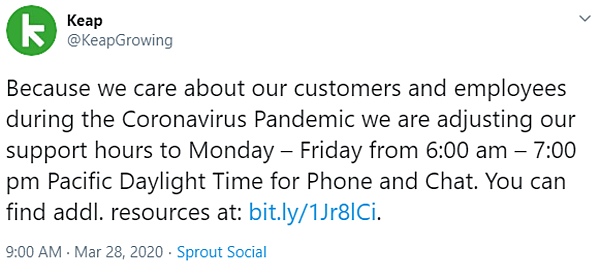“What do I do if I get sick?”
“What if I have to stay home to take care of a sick family member?”
“I can’t finish that project because it’s taking me three hours to get groceries. What now?”
These are just some of the questions employees have been asking over the past few weeks as we all deal with the global coronavirus crisis. They’re looking to their company leaders for guidance in these very uncertain and anxiety-filled times.
The World Health Organization and our public health officials are coaching us on how to avoid contracting and spreading the coronavirus, but what about our mental health? How can we stay emotionally healthy when there’s so much fear and anxiety around us?
If your company is still operating, you can support the mental health and safety of your employees with these tips:
1. Communicate, share, and be open
We get scared and worry when we don’t have a clear picture of a situation, especially one like a public health scare that impacts us from all sides. As an employer, you can help with that by letting your employees know you’ll be sending them regular updates. Communicate with them even if the situation hasn’t changed—they’ll appreciate hearing from you.

How leaders behave in times like these leaves a lasting impression on your company’s corporate culture. Employees will remember that you were communicative, proactive, and modeled calmness as the situation evolved. In these uncertain times, employees are looking to company leaders for direction and confidence.
A Canadian friend of mine told me she’s been comforted by the daily press conferences the Prime Minister does, even if he only talks for 10 minutes. The fact that he’s showing up daily and talking about how he’s still working and governing gives her a feeling of stability in a world that’s currently very dynamic and fluid—you can do the same for your employees.
One thing to remember is to think and talk about the future too. Things will get better at some point, so make sure to tell employees that's that case. Be positive in your communications.
2. Have a plan
As government and public health leaders take care of the world at large, you must take care of your employees. Job security stress reduces people’s physical and mental health, increases burnout, reduces job satisfaction, and decreases work performance. Let them know you’re thinking and looking ahead, that you’ll stay well-informed, and that you may be able to answer the questions they already have.
Keep employees informed on the plans for any work disruptions that might happen due to public health guidelines, changes in your supply chain or industry, and most importantly, what employees should do if they or a family member gets sick. Have a clear playbook that outlines the processes and procedures for a shutdown and how to reroute work and employees (if required). This includes a call or communication tree to disseminate urgent information to employees in the case of a critical shutdown or notice.
Consider compiling this information in a visible, online location so everyone can access it, such as your company intranet, wiki, or shared drive. Or create a company newsletter to highlight specific information about the crisis and how the company’s reacting and preparing. Direct employees to these resources often so they can see what’s changed and if they need to do anything differently when it comes to their work.
It’s also important for companies to have a clear plan for reactivation once the public health crisis has passed. Even if it takes months before that happens, it can be comforting to employees to know that company leaders know exactly what to do to restart work and what to expect when that all clear is given.
3. Educate cautiously
Fear of the unknown is one of the bigger triggers of anxiety, so if you’re able to remove some of that fear through education, do it. Your company should explain how they’re keeping employees safe, outline the self-protection guidelines for employees who are still required to be on-site, and increase awareness of coronavirus risk prevention. They will appreciate seeing that you’re aware of this and are handling it appropriately.
One caveat when talking about a public health crisis like coronavirus: beware of the unverified health information found online. Only communicate information from verified sources like your local and national public health officials, other government officials, and the World Health Organization, as these are created and communicated by members of the scientific and healthcare communities. When in doubt, do not pass the information along.
4. Connect with employees
As a fully-remote company, we have employees all over the world and we use Slack to communicate and build connections with each other. Especially now, when everyone’s dealing with the coronavirus pandemic. We’ve got various work-related channels that help us stay on track, but we also knew that we’d need a space for all employees to talk about non-work things too.
Our #family Slack channel is where employees share news about what’s going on in their part of the world, something that’s comforting right now. We have people sharing photos of their new pet coworkers, parents sharing homeschooling tips for their kids, others sharing pantry recipes, and more. It started as a way for us to connect as a remote company, but during this coronavirus crisis, we’re using it as a comfort blanket, trying to inject some normalcy into our strange days.
We encourage everyone, from our founders to employees, to share what they’re feeling as we navigate these challenging times. It’s easy to feel scared and alone even when working as a team online, but hearing how everyone is doing can help.
If your company isn’t used to working remotely, why not host a regular online video conference where employees can get together to chat virutally? It can help alleviate some of the isolation we’re all feeling, even if we’re at home with other family members. We just set up a weekly Zoom call company-wide that anyone can join and they don’t even have to speak if they don’t want to! They can just sit and listen to everyone else talk, as if they were in a coffee shop or the company lunch room.
Whatever you do, be sure you know how to use the tool, as someone shared a video conference #fail on Twitter recently:

Otherwise you could end up as a potato for an entire team meeting! But hey, a situation like this could lighten the mood when everyone’s feeling uneasy.
5. Understand and be aware
Empathy is one thing, but understanding and awareness at a grassroots level is also important now. You need to be able to recognize the signs of stress in your employees and if they’re feeling “off." Too much stress can lead to anxiety and other physical illnesses as people try to cope with it.
The best way to help employees is to get to know your team and try to notice any obvious changes in behavior that are uncharacteristic for them. For example, are they:
Missing online meetings?
Only using audio and turning off their video cameras during online meetings?
Not responding to messages in a timely manner (keeping in mind that everyone’s “norm” might have changed if they’re now working from home and have to deal with new distractions and challenges)?
More irritable in communications with you?
Taking more sick days than they used to?
My remote company uses the Standuply app in Slack to do a daily stand-up meeting with employees. We cover the usual status updates, but we also inquire about employee health and wellness, so if something changes, we can go back and compare it to previous messages. This tool helps us get to know employees and also stay updated so we can spot these changes and reach out if needed.
You can also encourage employees to practice self-care activities while on the job and reassure them it’s OK to take whatever steps they need to manage their stress. For those working from home, it might be listening to relaxing music as they work or connecting with family and friends throughout the workday. For those still working at physical locations, that might mean giving employees more regular breaks (especially for front-line workers) or providing them with free meals or snacks to thank them for continuing to work during this tough time.
This is not 'business as usual'
It's most definitely NOT business as usual right now, and it won’t be for a while. As we deal with so much uncertainty around us, it can be such a help if company leaders can help alleviate the stress and anxiety employees might be feeling. There’s only so much you can do, of course, but by taking care of things on your end, you’ll set a good example for the future and, hopefully, provide them with some comfort in these stressful times.


